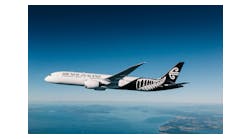Oct. 16--AirAsia X (AAX), the medium-to-long-haul arm of Asia's largest low-cost carrier franchise, is confident it can build up its brand to become a regional market leader despite a fare-cutting war among airlines.
Subsidiary Thai AirAsia X (TAAX) could launch flights by the end of the year after Thai authorities approved its operating licence on Oct 8.
AAX chief executive Azran Osman-Rani said the airline has big plans for Thailand next year.
"Even though our brand is not yet on a par with some established airlines, we believe we can build up our name on new medium-haul routes soon," said Mr Rani, a founder of AAX when it launched in 2007 in Malaysia.
"Bangkok is our second base. The joint venture with Thai partners is set. After getting licence approval, we are ready to get new planes and [business] can take off."
Mr Rani was speaking to the Bangkok Post after an executive meeting in Bangkok recently.
The Thai unit is a three-way joint venture between Thai AirAsia chief executive Tassapon Bijleveld (41%), Julpas Kruesopon, president of Panda Security (US and Asia Pacific) and adviser to Prime Minister Yingluck Shinawatra (10%), and AirAsia X Bhd (49%).
The airline has started recruiting staff including flight attendants and pilots.
Initial routes will likely be Australia and North Asia including Japan, South Korea and China. If the business achieves its goal of 150,000 passengers in 2014, routes to Russia, Turkey and the Middle East are likely to be added.
Mr Rani declined to talk about the unit's investment as its shareholders have yet to conclude financial matters. "The shareholders also need to work out their own capital. Once the finance is all set, we will move forward to details such as whether we buy brand-new or used planes. I can only say that we have decided to kick off with two young A330 airplanes," said Mr Rani.
Thailand is its immediate priority as a second base after Malaysia as the country has great potential to grow business, he said.
Thailand is expected to record robust growth in tourist arrivals to reach about 25 million this year, while the number of Thai travellers, both domestic and international, has also surged.
Thailand's six main airports recorded a 20.43% rise in passenger traffic to 86.13 million in the fiscal year to last month over the previous year.
Aircraft movements increased by 16.46% to 559,397, according to figures from Airports of Thailand Plc.
Mr Rani said the outlook for Thailand-North Asia routes is very promising after Japan removed its visa requirement for Thai passport holder, while the number of Chinese tourists to Thailand is showing phenomenal growth.
Although low-cost carriers' penetration rates within Southeast Asia are above 50%, the medium-haul market to other parts of the Asia-Pacific region is still relatively untapped.
AAX is now focusing on this medium-haul market after its long-haul network to Europe was revoked last year in a bid to improve profitability.
After low-cost carriers gave a huge boost to the number of flyers in Asean countries, AAX expects the medium-haul market to progress in the same manner, said Mr Rani.
However, he admitted that competition among airlines is increasingly intense as full-service airlines jump into the fare-cutting war.
Mr Rani said fuel and operating costs are the keys to success for profitable airlines. Low-cost carriers' operating cost per seat per kilometre is 3.7 US cents, about half the 7-8 cents of some full-service airlines.
"They [full-service airlines] are operating at high cost with marginal profits already, and now they have played on the cheap fares, it means more expenses for them," said Mr Rani.
AAX's fuel cost is 1.8 cents per seat per kilometre, while full-service airlines pay 3.8 cents on average, as it can cut tonnes of weight by having limited services for entertainment and meals.
However, both low-cost and full-service airlines face the same challenges.
Mr Rani said the lack of loans in Asean currencies is a major difficulty for the regional aviation sector. Airlines need to buy million-dollar aircraft in US dollar terms offered by foreign banks.
"Stronger Asean currencies are a major challenge. We have to manage carefully as we earn in local currencies but service debt in dollar terms," he said.
Copyright 2013 - Bangkok Post, Thailand




